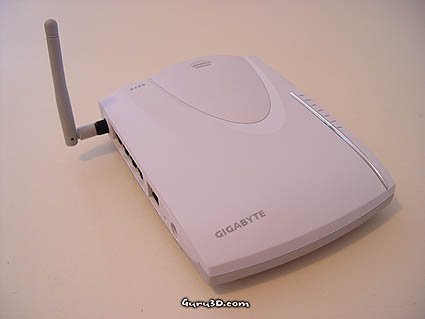Page 6 - Dual port what?
Dual port what?Dual port on a wireless connection, now theres a thought. Thats how the router claims to get 108Mbps instead of the standard 54Mbps that wireless G provides. Compare that to the now slightly dated 802.11b (11Mbps) and this turbo mode is almost 10 times faster on paper. So how on earth does it work?
The turbo mode is a feature from a company called atheros, both access point and adapter must support that mode otherwise you will be limited back down to 54Mbps. In this case Gigabyte have used atheros base designs on both the router and the adapter thus 108Mbps mode can be used. If you want some more info on atheros, then head over to their website: http://www.atheros.com
Wireless and the transfer rates (aka rant at marketing)
If you have ever read any review on wireless comms, or indeed you have bought some wireless kit in the past. You will be aware that when it says 11Mbps on the box, your real world rates are very much less than that. We are talking with a good signal, a 11Mbps card will probably only reach 4-5Mbps. The reason is to do with the medium, i.e radio waves. With a wired network like you traditional Ethernet based LAN, the amount of errors that occur down the line either induced by collisions or by noise are relatively small. There is quite a lot of theory behind of that, including quite a mass of maths, have a read of a decent networking book if you are really that interested. When we swap over to a wireless network, we deal with a huge amount of external factors that can mess up communication, signal strength, noise, collisions (big one as the propogation over RF is greater than wired networks, so you cannot sense the line, as what you are sensing is out of date by a good few milliseconds, considering we are trying to transfer multiple megabits per second, those milliseconds count).
Having said all of the above, a wired network when it finds a collision or error of some kind, the adapter will hold off a random amount of time and try again. However since most of the errors in a wireless network are not induced by the adapter or the access point, the idea of holding off and waiting for the error to pass, is a bad idea. Instead the wireless protocols try and push the communication through. 11Mbps is the maximum transmit rate, however due to all of the above, much of that time is spent retransmitting failed packets and thus our real world transfer rates come down to about 5Mbps or so.
Now the techies who make all this kit know that, but the marketing people jazz it up to the theoretical maximum, whether that be 54Mbps or 108Mbps. You cant blame them for trying I suppose, but you cant help but get annoyed when you all now know that we will never see the theoretical limit of this type of kit. (We could also complain a little at wired networks, as we never get 100Mbit/s however we do get real world benchmarks similar to the stated max (60-80%) where as wireless gets <50% with a decent signal.)

Ok its not on, but is it fast?
